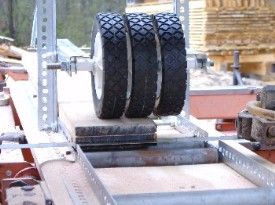Q.
My parents are having a house built, and if I take the trees before the lot is cleared they are mine. I have access to a 20-by-20-by-26 barn for air drying, and believe I can make a crude sawmill setup for limited use. Many trees are 6-inch diameter oaks and maples, and there's also 12-inch pines, along with a few much larger trees.
My question: Will I encounter any special problems because of the small size of the logs? I will be using the materials to build a 20-foot catamaran. Most of the oak will be made into 2-by-2s. Any tips, ideas, opinions?
Six-inch logs will yield little material larger than 2-by-2, and only then if they're straight; but 2-by-2s sawn out of small trees like these will probably be difficult to dry straight. The tight grain arc and juvenile wood will make them unstable.
None of the species you mention are typically used in boat construction; further, boatbuilding is usually done with very high grade lumber, often vertical grain, neither of which can be expected from small trees. From what you've said, I don't think harvesting this wood for boatbuilding is worth your time. The pine in particular, though, may be useful for other things.
That's just the problem: When dealing with juvenile wood, it's a crap shoot. It may do OK, it may not, but most likely not.
If you're dead-set on using these to get the 2-by-2s you need, you might try getting some pieces off the sides instead of from the heart. You might be able to squeak out two pieces from the outside of the logs rather than four from the heart.
If you want to go ahead with it, by all means do it; if nothing else, you'll learn a lot. I still think there's a better-than-even chance it won't work out. If you're steam-bending, you still need a piece of straight-grained, uniform wood to get a good bend. And remember that even if the lower trunk is clear of limbs now, it wasn't at one time and those knots are buried down in the center of the log.
To get a clear 2-by-2 out of a 6-inch diameter log (assuming it's absolutely dead straight), the tree would have had to be clear of limbs at that height when it was 1 inch in diameter, and this is not likely. In addition, when trees are small they often waver as they grow, so the pith isn't dead straight -- this will make it even more difficult to get clear blanks that avoid the pith.
There are issues in the bending end of this also. You can't take a warped blank and bend a fair curve (since you're bending these 2-by-2s, I assume you're making ribs). The same irregularities and stresses in the grain that cause the warp are likely to cause irregularities in the bent piece. Any knots, or irregular grain covering old knots, will cause spots that won't bend fair with the rest of the piece.
Think of it this way: Take a straight-grained 2-by-2, then put a 1/4-inch-deep nick in one face, then bend it. You'll wind up with a sharp spot in the bend where the wood is weak.
Consider this: Though you say you've got 6 inches in diameter, probably two of those six inches is sapwood, which is not decay resistant like the heartwood of white oak is (I assume this must be white oak if you're going to use it in a boat), and is therefore not suitable for boatbuilding.
Consider too the impact of having poor-quality material in the construction of your boat. Think of the time you'll have invested in getting set up to saw, drying and milling the blanks, then bending each one. If you have a failure rate of one-third because of poor-quality material, your time was poorly spent compared to buying high-grade material that's well suited to your purpose. Chop the 6-inch oak into firewood and sell that; use the proceeds to pay for better material.
Sawing your own wood for a project can be a really rewarding thing, but not if you jeopardize your project by working with stock that isn't up to the task.
Then I will pick the biggest, straightest oak and see how it goes. With everything that is obviously unsuitable, I'll do as you suggest: Sell the BTUs.
